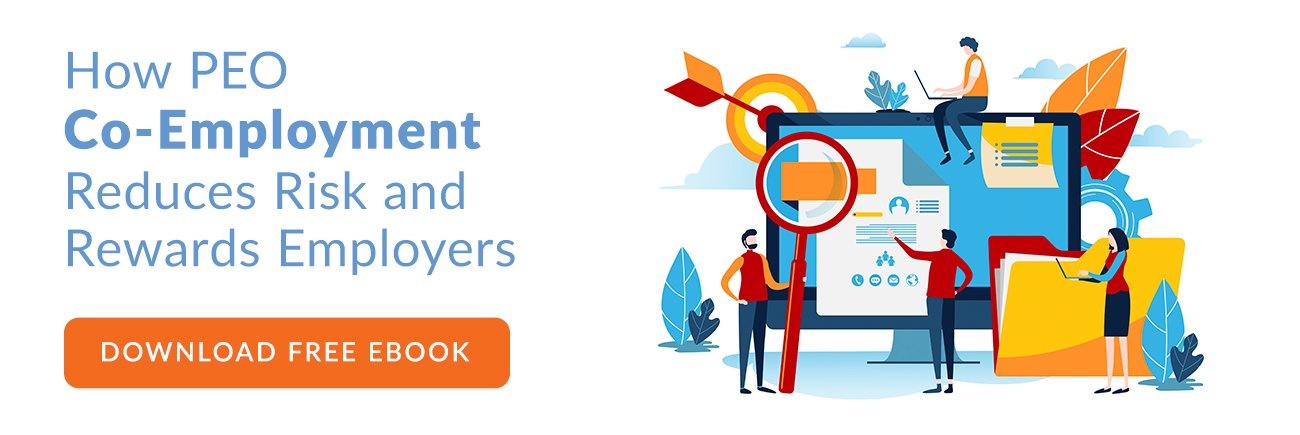Organizations have long sought ways to reduce risk in the workplace. Increasingly, co-employment is being seen as a viable solution.
This article will explore the various strategies that can be employed to ensure success and the potential risks associated with such an approach. Similarly, this article will offer practical advice on how organizations can optimize their risk mitigation efforts through co-employment.
Organizations can better protect themselves from liability issues by understanding the theory behind this concept and its application in practice.
What Is Co-Employment?
Co-employment is a legal business relationship between two entities, such as a client company and a professional employer organization (PEO). In a co-employment relationship, the PEO becomes the “employer of record” for the client’s workforce, while the client retains control over day-to-day management.
The PEO assumes responsibility for various administrative functions such as payroll processing, compliance management, employee benefits administration, labor law consulting, and more. By leveraging the resources of a PEO, clients can benefit from cost savings in areas where they may lack expertise or resources.
The strategic use of co-employment can improve risk mitigation by transferring certain employment liabilities to the PEO. The PEO’s deep experience in human resources and labor law helps ensure that clients comply with applicable laws and regulations.

Benefits Of Co-Employment
Co-employment can help organizations save on costs associated with hiring and administrating a workforce.
Legal protection is provided to organizations by having a co-employer take on the liability of being the employer of record.
Co-employment arrangements can help to reduce the administrative burden on organizations by providing access to additional resources and support.
Cost Savings
Co-employment is a cost-saving solution for organizations looking to reduce the financial burden of managing their HR needs.
By partnering with a professional employer organization (PEO) or co-employer, an organization can access streamlined HR analytics and outsource certain HR services.
Additionally, co-employment can provide organizations with access to employee benefits programs that are not typically available when managing employees on their own.
Consequently, businesses can focus more on core business operations while reducing risk profiles due to improved compliance management.
In this way, co-employment offers a unique approach to cost savings through improved efficiency and reduced financial risks.
Legal Protection
One of the key benefits of co-employment is legal protection. By partnering with a PEO or co-employer, organizations are provided with an additional layer of legal protection that helps to ensure compliance with fundamental employment laws and regulations.
This provides organizations with peace of mind knowing that, for example, Equal Employment Opportunity (EEO) legal compliance is current. This benefit helps reduce the risk associated with litigation and any potential financial liabilities resulting from non-compliance.
As such, co-employment allows organizations to protect themselves financially while providing an extra layer of security for their employees.
Administrative Burden Reduction
Co-employment also significantly reduces the administrative burden of managing an organization’s workforce.
Professional employer organizations (PEOs) specialize in providing comprehensive and cost-effective Human Resources (HR) services that help reduce the complexity of managing multiple employment liability risks.
PEOs also supply processes, systems, and resources to ensure compliance with applicable employment laws and regulations. Your PEO can also provide education and training to employees and managers on essential topics such as workplace harassment, discrimination, and equal employment opportunity (EEO).
Ultimately, a PEO can significantly reduce an organization’s administrative burden while ensuring that their HR operations are compliant and up to date.
How Co-Employment Reduces Risk
By entering into a co-employment agreement with a professional employer organization (PEO), companies can access the expertise of HR professionals, payroll processing, and risk assessment.
From the operational side, co-employment offers a variety of benefits that help reduce risk. Co-employers share responsibility for filing payroll taxes, labor law compliance, employee benefits administration, and more.
This can significantly benefit small- to medium-sized companies that may not have the resources or personnel to properly manage these tasks in-house.
In short, co-employment allows businesses to focus on their core competencies while having peace of mind knowing that their HR and operations responsibilities are being taken care of by professionals who specialize in those areas. The result is improved risk mitigation and greater financial savings due to increased efficiency and accuracy in managing payroll processing and compliance-related tasks.
The Impact Of Co-Employment On Compliance
By using co-employment, organizations can benefit from the expertise of PEOs to support their compliance responsibilities, including federal and state wage and hour laws, OSHA safety regulations, Family Medical Leave Act (FMLA) requirements, and other related regulations.
The effects of co-employment on compliance are both immediate and long-term.
PEOs are uniquely equipped to handle the complexities of human resources administration, providing organizations with up-to-date policies and procedures that meet all federal and state standards.
Additionally, PEOs provide access to exclusive training programs that ensure employees remain informed on the most recent regulations and understand their rights under applicable laws.
This level of support helps organizations maintain regulatory adherence while reducing their overall financial risk due to costly non-compliance fines.
As such, co-employment can be a powerful tool for controlling costs while ensuring workplace compliance.

How To Leverage Co-Employment For Risk Mitigation
There are three essential steps to take full advantage of the benefits of co-employment:
- Understanding the risks associated with co-employment is essential to properly develop a plan for mitigating them.
- Create a comprehensive plan to address the risks of co-employment in order to ensure compliance and positive outcomes.
- Leveraging co-employment opportunities to mitigate risk can provide organizations with the necessary support and resources to remain compliant and successful.
Understand Risks
Knowing the risks you face is critical in leveraging co-employment for risk mitigation. Companies must be aware of the potential dangers of doing business as usual.
With co-employment, your company can minimize these risks by partnering with an experienced Professional Employer Organization (PEO) with the expertise to help manage your workforce. By outsourcing specific employee management tasks such as payroll and benefits, companies can free up time to focus on core objectives and reduce their exposure to employment-related liabilities.
Additionally, PEOs have access to tools to help ensure legal compliance and audit readiness, further reducing liability. By understanding the risks associated with hiring employees and taking steps to mitigate them through co-employment, companies can create a safe working environment for their employees while protecting themselves from potential financial losses.
Develop A Plan
Organizations must develop a plan that incorporates conflict resolution and performance management to effectively leverage co-employment for risk mitigation.
For example, companies can use PEOs to create an effective workflow system and provide employees with the necessary tools for resolving workplace conflicts.
Additionally, by developing policies to address employee performance issues, companies can ensure that employees are held accountable for their actions and take responsibility for their behavior.
Companies should also consider providing training and development programs that improve employee engagement and job satisfaction.
Organizations will be better prepared to handle employment risks and reduce their potential liabilities when these steps are taken in conjunction with partnering with a PEO.
Leverage Co-Employment
Once a plan is in place and organizations have established the necessary policies and practices to mitigate risks, they can leverage co-employment to maximize their success.
This includes creating employee handbooks outlining expectations and rules, conducting background checks and screenings, and investing in training and development programs.
By doing so, companies can ensure that employees are held accountable for their actions and that organizational objectives are met.
In addition, by fostering an environment of collaboration, organizations can create a culture of trust that encourages innovation and success.
With these steps in place, organizations will be better equipped to handle employment risks while still achieving their desired outcomes.
Beyond Mitigating Risk
Implementing co-employment through Professional Employment Organizations (PEOs) has benefits beyond reducing employer risks.
For example, in co-employment you gain access to the PEO’s benefits master plan, which was negotiated using economies of scale. That means you can provide Fortune 500-level employee benefits at a more affordable cost than you could get on your own.
Similarly, co-employment enables your business to access the PEO’s workers’ comp plan where the upfront premium has already paid. That means that, instead of paying your premium upfront, you can pay as you go on a monthly schedule.
As a bonus, you can adopt the PEO’s experience modifier rate (EMR). If their rate is lower than yours, it could lead to a reduction in your monthly premiums.



